Food Safety Management Report: Hilton Hotel, HND Hospitality
VerifiedAdded on 2020/10/05
|12
|3306
|354
Report
AI Summary
This report provides a detailed analysis of food safety management, specifically focusing on the context of the Hilton Hotel. It begins with an introduction to food safety and hygiene, emphasizing its importance in the competitive market. The report then delves into the causes of food spoilage, categorizing agents like microorganisms, insects, and chemical changes. It outlines various methods of food preservation, including filtration, dehydration, refrigeration, and vacuum packing. The report further discusses temperature control systems, storage methods like freezing and canning, and the importance of staff hygiene to prevent contamination. It also addresses cleaning, disinfection, and pest control practices within a food premises. The report concludes by highlighting the design and construction of food premises to maintain hygiene effectively, ensuring that the Hilton Hotel adheres to the highest standards of food safety.
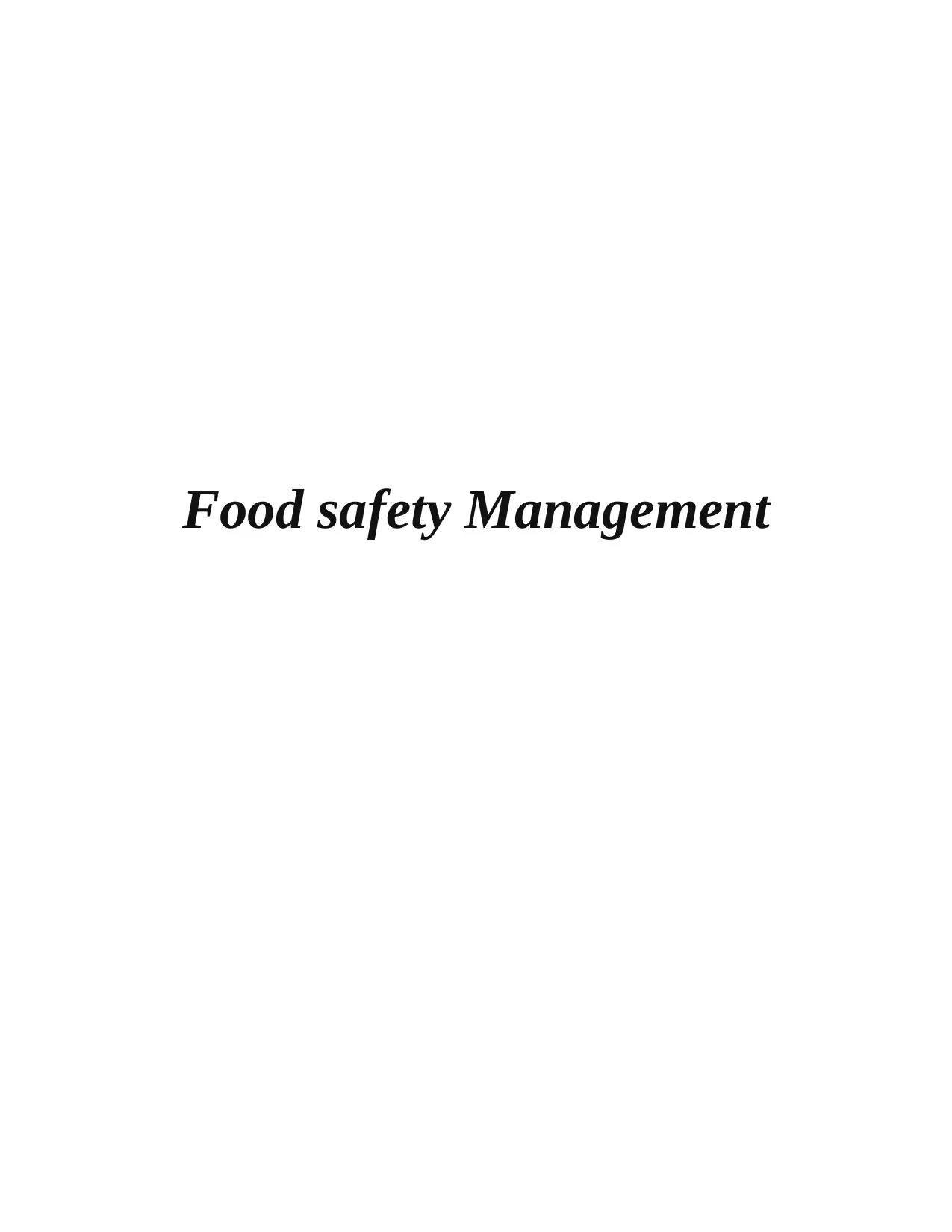
Food safety Management
Paraphrase This Document
Need a fresh take? Get an instant paraphrase of this document with our AI Paraphraser
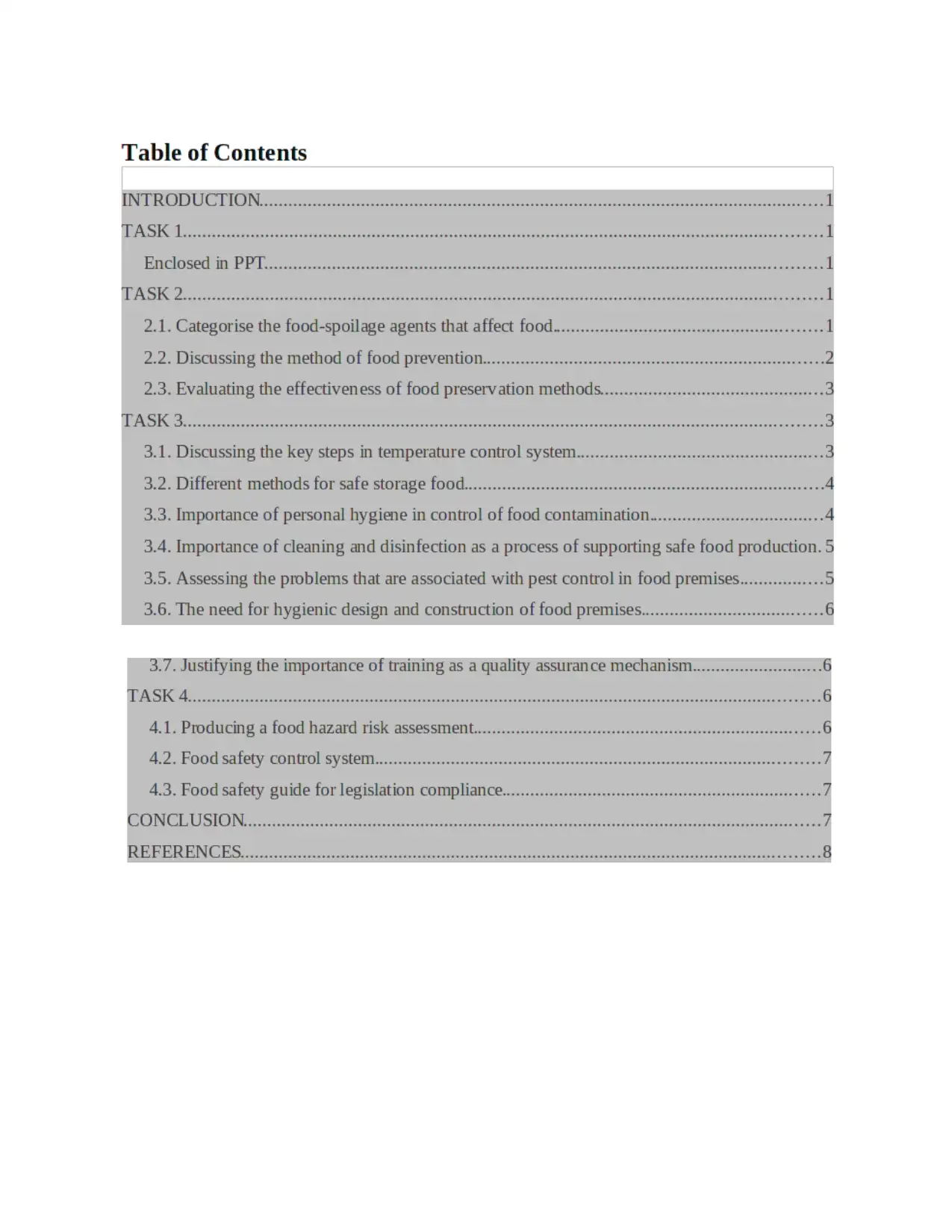
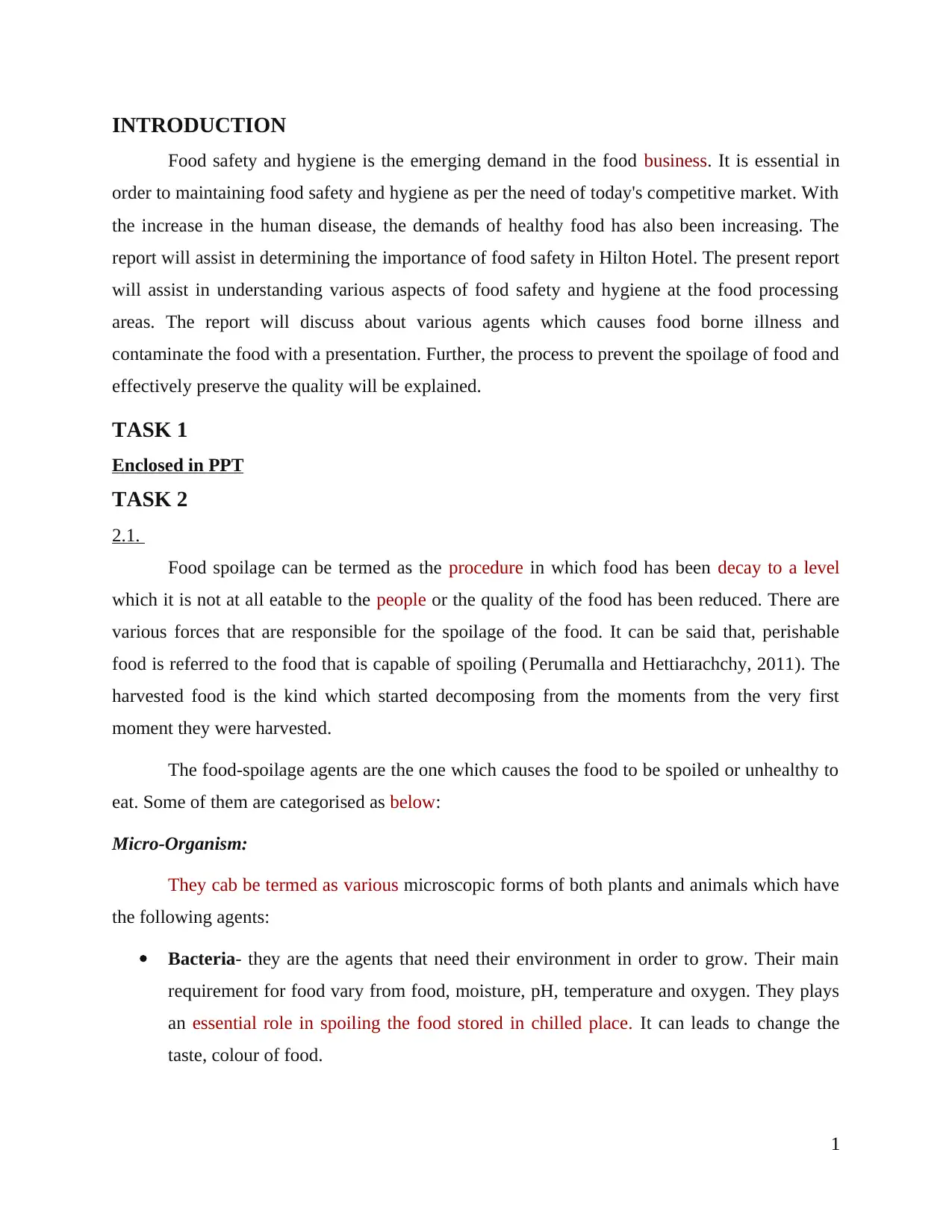
INTRODUCTION
Food safety and hygiene is the emerging demand in the food business. It is essential in
order to maintaining food safety and hygiene as per the need of today's competitive market. With
the increase in the human disease, the demands of healthy food has also been increasing. The
report will assist in determining the importance of food safety in Hilton Hotel. The present report
will assist in understanding various aspects of food safety and hygiene at the food processing
areas. The report will discuss about various agents which causes food borne illness and
contaminate the food with a presentation. Further, the process to prevent the spoilage of food and
effectively preserve the quality will be explained.
TASK 1
Enclosed in PPT
TASK 2
2.1.
Food spoilage can be termed as the procedure in which food has been decay to a level
which it is not at all eatable to the people or the quality of the food has been reduced. There are
various forces that are responsible for the spoilage of the food. It can be said that, perishable
food is referred to the food that is capable of spoiling (Perumalla and Hettiarachchy, 2011). The
harvested food is the kind which started decomposing from the moments from the very first
moment they were harvested.
The food-spoilage agents are the one which causes the food to be spoiled or unhealthy to
eat. Some of them are categorised as below:
Micro-Organism:
They cab be termed as various microscopic forms of both plants and animals which have
the following agents:
Bacteria- they are the agents that need their environment in order to grow. Their main
requirement for food vary from food, moisture, pH, temperature and oxygen. They plays
an essential role in spoiling the food stored in chilled place. It can leads to change the
taste, colour of food.
1
Food safety and hygiene is the emerging demand in the food business. It is essential in
order to maintaining food safety and hygiene as per the need of today's competitive market. With
the increase in the human disease, the demands of healthy food has also been increasing. The
report will assist in determining the importance of food safety in Hilton Hotel. The present report
will assist in understanding various aspects of food safety and hygiene at the food processing
areas. The report will discuss about various agents which causes food borne illness and
contaminate the food with a presentation. Further, the process to prevent the spoilage of food and
effectively preserve the quality will be explained.
TASK 1
Enclosed in PPT
TASK 2
2.1.
Food spoilage can be termed as the procedure in which food has been decay to a level
which it is not at all eatable to the people or the quality of the food has been reduced. There are
various forces that are responsible for the spoilage of the food. It can be said that, perishable
food is referred to the food that is capable of spoiling (Perumalla and Hettiarachchy, 2011). The
harvested food is the kind which started decomposing from the moments from the very first
moment they were harvested.
The food-spoilage agents are the one which causes the food to be spoiled or unhealthy to
eat. Some of them are categorised as below:
Micro-Organism:
They cab be termed as various microscopic forms of both plants and animals which have
the following agents:
Bacteria- they are the agents that need their environment in order to grow. Their main
requirement for food vary from food, moisture, pH, temperature and oxygen. They plays
an essential role in spoiling the food stored in chilled place. It can leads to change the
taste, colour of food.
1
⊘ This is a preview!⊘
Do you want full access?
Subscribe today to unlock all pages.

Trusted by 1+ million students worldwide
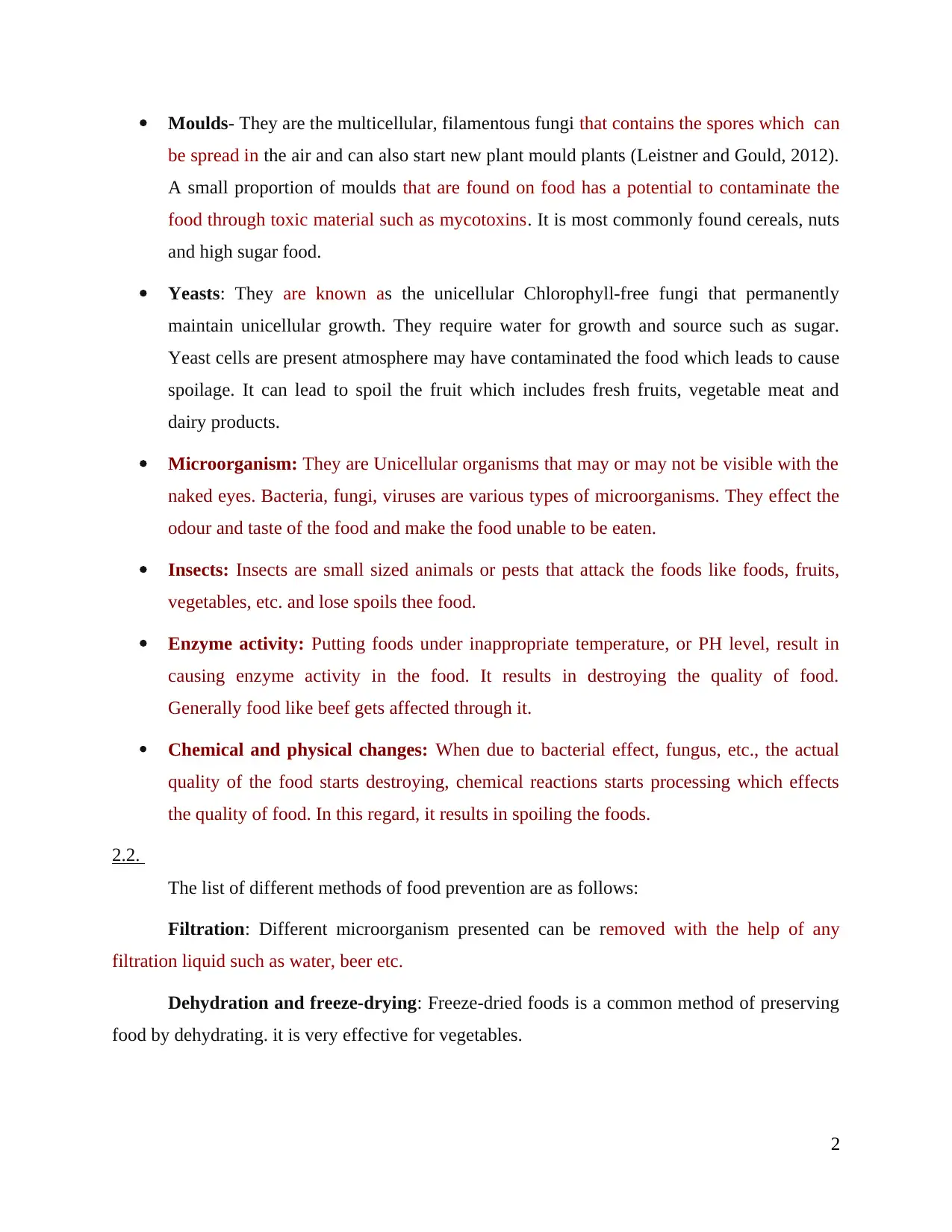
Moulds- They are the multicellular, filamentous fungi that contains the spores which can
be spread in the air and can also start new plant mould plants (Leistner and Gould, 2012).
A small proportion of moulds that are found on food has a potential to contaminate the
food through toxic material such as mycotoxins. It is most commonly found cereals, nuts
and high sugar food.
Yeasts: They are known as the unicellular Chlorophyll-free fungi that permanently
maintain unicellular growth. They require water for growth and source such as sugar.
Yeast cells are present atmosphere may have contaminated the food which leads to cause
spoilage. It can lead to spoil the fruit which includes fresh fruits, vegetable meat and
dairy products.
Microorganism: They are Unicellular organisms that may or may not be visible with the
naked eyes. Bacteria, fungi, viruses are various types of microorganisms. They effect the
odour and taste of the food and make the food unable to be eaten.
Insects: Insects are small sized animals or pests that attack the foods like foods, fruits,
vegetables, etc. and lose spoils thee food.
Enzyme activity: Putting foods under inappropriate temperature, or PH level, result in
causing enzyme activity in the food. It results in destroying the quality of food.
Generally food like beef gets affected through it.
Chemical and physical changes: When due to bacterial effect, fungus, etc., the actual
quality of the food starts destroying, chemical reactions starts processing which effects
the quality of food. In this regard, it results in spoiling the foods.
2.2.
The list of different methods of food prevention are as follows:
Filtration: Different microorganism presented can be removed with the help of any
filtration liquid such as water, beer etc.
Dehydration and freeze-drying: Freeze-dried foods is a common method of preserving
food by dehydrating. it is very effective for vegetables.
2
be spread in the air and can also start new plant mould plants (Leistner and Gould, 2012).
A small proportion of moulds that are found on food has a potential to contaminate the
food through toxic material such as mycotoxins. It is most commonly found cereals, nuts
and high sugar food.
Yeasts: They are known as the unicellular Chlorophyll-free fungi that permanently
maintain unicellular growth. They require water for growth and source such as sugar.
Yeast cells are present atmosphere may have contaminated the food which leads to cause
spoilage. It can lead to spoil the fruit which includes fresh fruits, vegetable meat and
dairy products.
Microorganism: They are Unicellular organisms that may or may not be visible with the
naked eyes. Bacteria, fungi, viruses are various types of microorganisms. They effect the
odour and taste of the food and make the food unable to be eaten.
Insects: Insects are small sized animals or pests that attack the foods like foods, fruits,
vegetables, etc. and lose spoils thee food.
Enzyme activity: Putting foods under inappropriate temperature, or PH level, result in
causing enzyme activity in the food. It results in destroying the quality of food.
Generally food like beef gets affected through it.
Chemical and physical changes: When due to bacterial effect, fungus, etc., the actual
quality of the food starts destroying, chemical reactions starts processing which effects
the quality of food. In this regard, it results in spoiling the foods.
2.2.
The list of different methods of food prevention are as follows:
Filtration: Different microorganism presented can be removed with the help of any
filtration liquid such as water, beer etc.
Dehydration and freeze-drying: Freeze-dried foods is a common method of preserving
food by dehydrating. it is very effective for vegetables.
2
Paraphrase This Document
Need a fresh take? Get an instant paraphrase of this document with our AI Paraphraser
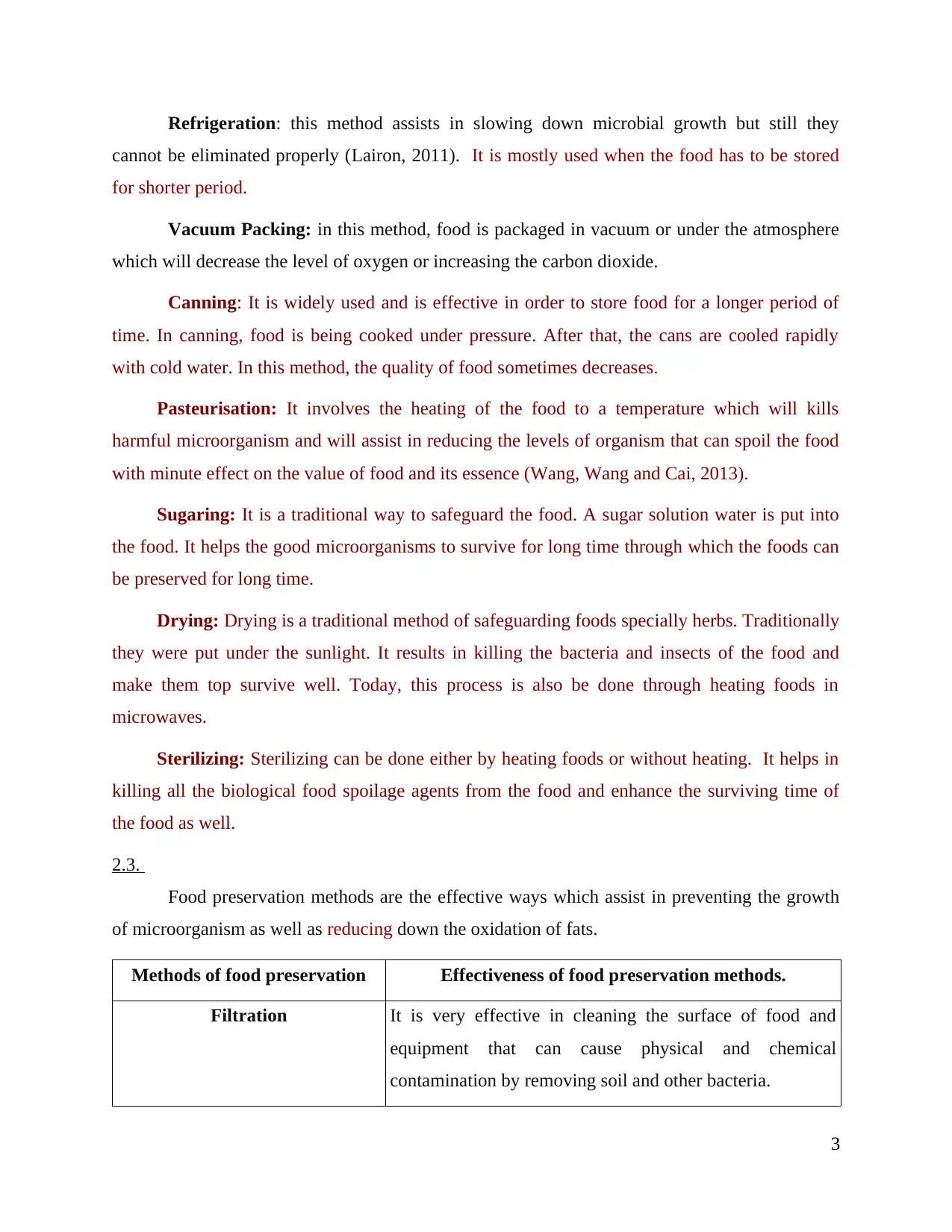
Refrigeration: this method assists in slowing down microbial growth but still they
cannot be eliminated properly (Lairon, 2011). It is mostly used when the food has to be stored
for shorter period.
Vacuum Packing: in this method, food is packaged in vacuum or under the atmosphere
which will decrease the level of oxygen or increasing the carbon dioxide.
Canning: It is widely used and is effective in order to store food for a longer period of
time. In canning, food is being cooked under pressure. After that, the cans are cooled rapidly
with cold water. In this method, the quality of food sometimes decreases.
Pasteurisation: It involves the heating of the food to a temperature which will kills
harmful microorganism and will assist in reducing the levels of organism that can spoil the food
with minute effect on the value of food and its essence (Wang, Wang and Cai, 2013).
Sugaring: It is a traditional way to safeguard the food. A sugar solution water is put into
the food. It helps the good microorganisms to survive for long time through which the foods can
be preserved for long time.
Drying: Drying is a traditional method of safeguarding foods specially herbs. Traditionally
they were put under the sunlight. It results in killing the bacteria and insects of the food and
make them top survive well. Today, this process is also be done through heating foods in
microwaves.
Sterilizing: Sterilizing can be done either by heating foods or without heating. It helps in
killing all the biological food spoilage agents from the food and enhance the surviving time of
the food as well.
2.3.
Food preservation methods are the effective ways which assist in preventing the growth
of microorganism as well as reducing down the oxidation of fats.
Methods of food preservation Effectiveness of food preservation methods.
Filtration It is very effective in cleaning the surface of food and
equipment that can cause physical and chemical
contamination by removing soil and other bacteria.
3
cannot be eliminated properly (Lairon, 2011). It is mostly used when the food has to be stored
for shorter period.
Vacuum Packing: in this method, food is packaged in vacuum or under the atmosphere
which will decrease the level of oxygen or increasing the carbon dioxide.
Canning: It is widely used and is effective in order to store food for a longer period of
time. In canning, food is being cooked under pressure. After that, the cans are cooled rapidly
with cold water. In this method, the quality of food sometimes decreases.
Pasteurisation: It involves the heating of the food to a temperature which will kills
harmful microorganism and will assist in reducing the levels of organism that can spoil the food
with minute effect on the value of food and its essence (Wang, Wang and Cai, 2013).
Sugaring: It is a traditional way to safeguard the food. A sugar solution water is put into
the food. It helps the good microorganisms to survive for long time through which the foods can
be preserved for long time.
Drying: Drying is a traditional method of safeguarding foods specially herbs. Traditionally
they were put under the sunlight. It results in killing the bacteria and insects of the food and
make them top survive well. Today, this process is also be done through heating foods in
microwaves.
Sterilizing: Sterilizing can be done either by heating foods or without heating. It helps in
killing all the biological food spoilage agents from the food and enhance the surviving time of
the food as well.
2.3.
Food preservation methods are the effective ways which assist in preventing the growth
of microorganism as well as reducing down the oxidation of fats.
Methods of food preservation Effectiveness of food preservation methods.
Filtration It is very effective in cleaning the surface of food and
equipment that can cause physical and chemical
contamination by removing soil and other bacteria.
3
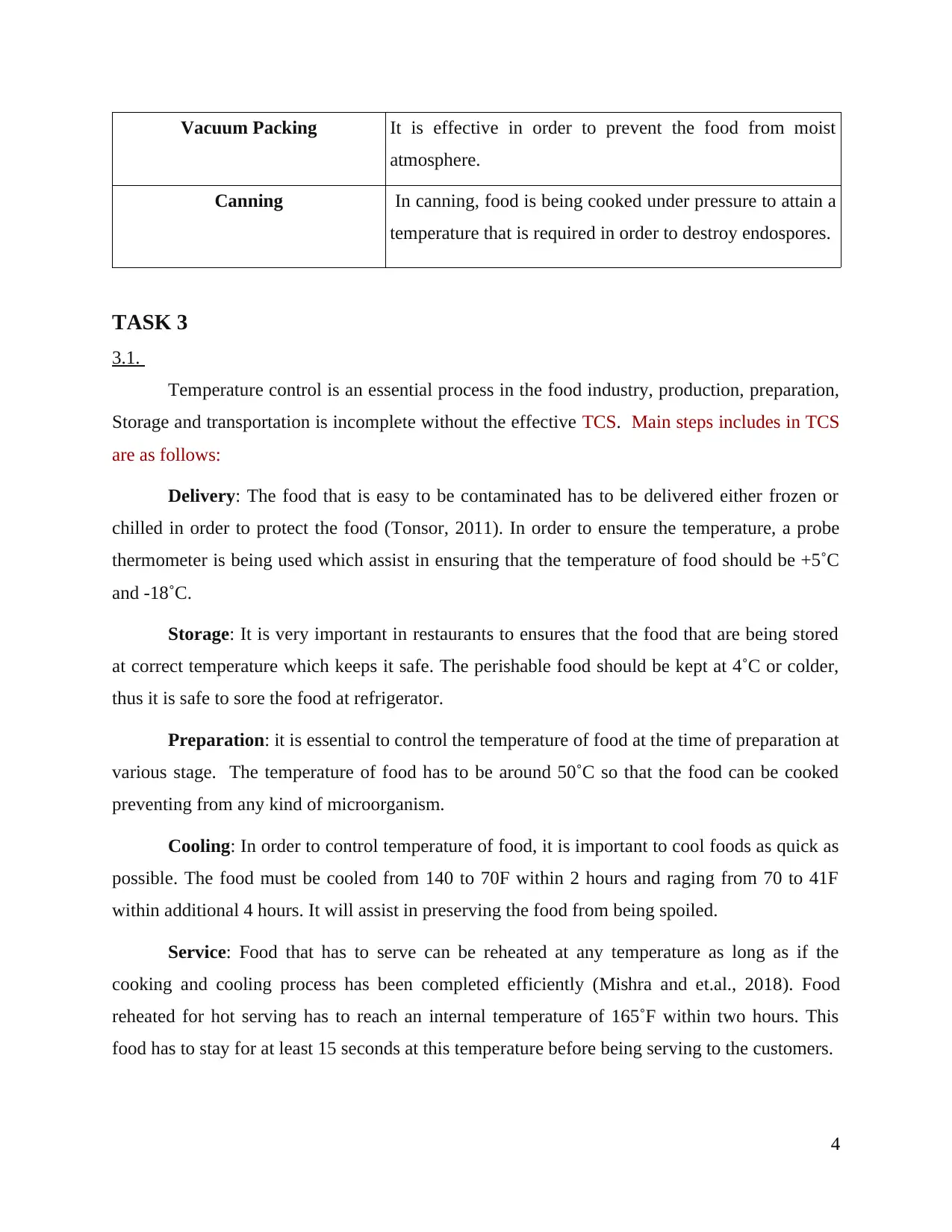
Vacuum Packing It is effective in order to prevent the food from moist
atmosphere.
Canning In canning, food is being cooked under pressure to attain a
temperature that is required in order to destroy endospores.
TASK 3
3.1.
Temperature control is an essential process in the food industry, production, preparation,
Storage and transportation is incomplete without the effective TCS. Main steps includes in TCS
are as follows:
Delivery: The food that is easy to be contaminated has to be delivered either frozen or
chilled in order to protect the food (Tonsor, 2011). In order to ensure the temperature, a probe
thermometer is being used which assist in ensuring that the temperature of food should be +5˚C
and -18˚C.
Storage: It is very important in restaurants to ensures that the food that are being stored
at correct temperature which keeps it safe. The perishable food should be kept at 4˚C or colder,
thus it is safe to sore the food at refrigerator.
Preparation: it is essential to control the temperature of food at the time of preparation at
various stage. The temperature of food has to be around 50˚C so that the food can be cooked
preventing from any kind of microorganism.
Cooling: In order to control temperature of food, it is important to cool foods as quick as
possible. The food must be cooled from 140 to 70F within 2 hours and raging from 70 to 41F
within additional 4 hours. It will assist in preserving the food from being spoiled.
Service: Food that has to serve can be reheated at any temperature as long as if the
cooking and cooling process has been completed efficiently (Mishra and et.al., 2018). Food
reheated for hot serving has to reach an internal temperature of 165˚F within two hours. This
food has to stay for at least 15 seconds at this temperature before being serving to the customers.
4
atmosphere.
Canning In canning, food is being cooked under pressure to attain a
temperature that is required in order to destroy endospores.
TASK 3
3.1.
Temperature control is an essential process in the food industry, production, preparation,
Storage and transportation is incomplete without the effective TCS. Main steps includes in TCS
are as follows:
Delivery: The food that is easy to be contaminated has to be delivered either frozen or
chilled in order to protect the food (Tonsor, 2011). In order to ensure the temperature, a probe
thermometer is being used which assist in ensuring that the temperature of food should be +5˚C
and -18˚C.
Storage: It is very important in restaurants to ensures that the food that are being stored
at correct temperature which keeps it safe. The perishable food should be kept at 4˚C or colder,
thus it is safe to sore the food at refrigerator.
Preparation: it is essential to control the temperature of food at the time of preparation at
various stage. The temperature of food has to be around 50˚C so that the food can be cooked
preventing from any kind of microorganism.
Cooling: In order to control temperature of food, it is important to cool foods as quick as
possible. The food must be cooled from 140 to 70F within 2 hours and raging from 70 to 41F
within additional 4 hours. It will assist in preserving the food from being spoiled.
Service: Food that has to serve can be reheated at any temperature as long as if the
cooking and cooling process has been completed efficiently (Mishra and et.al., 2018). Food
reheated for hot serving has to reach an internal temperature of 165˚F within two hours. This
food has to stay for at least 15 seconds at this temperature before being serving to the customers.
4
⊘ This is a preview!⊘
Do you want full access?
Subscribe today to unlock all pages.

Trusted by 1+ million students worldwide
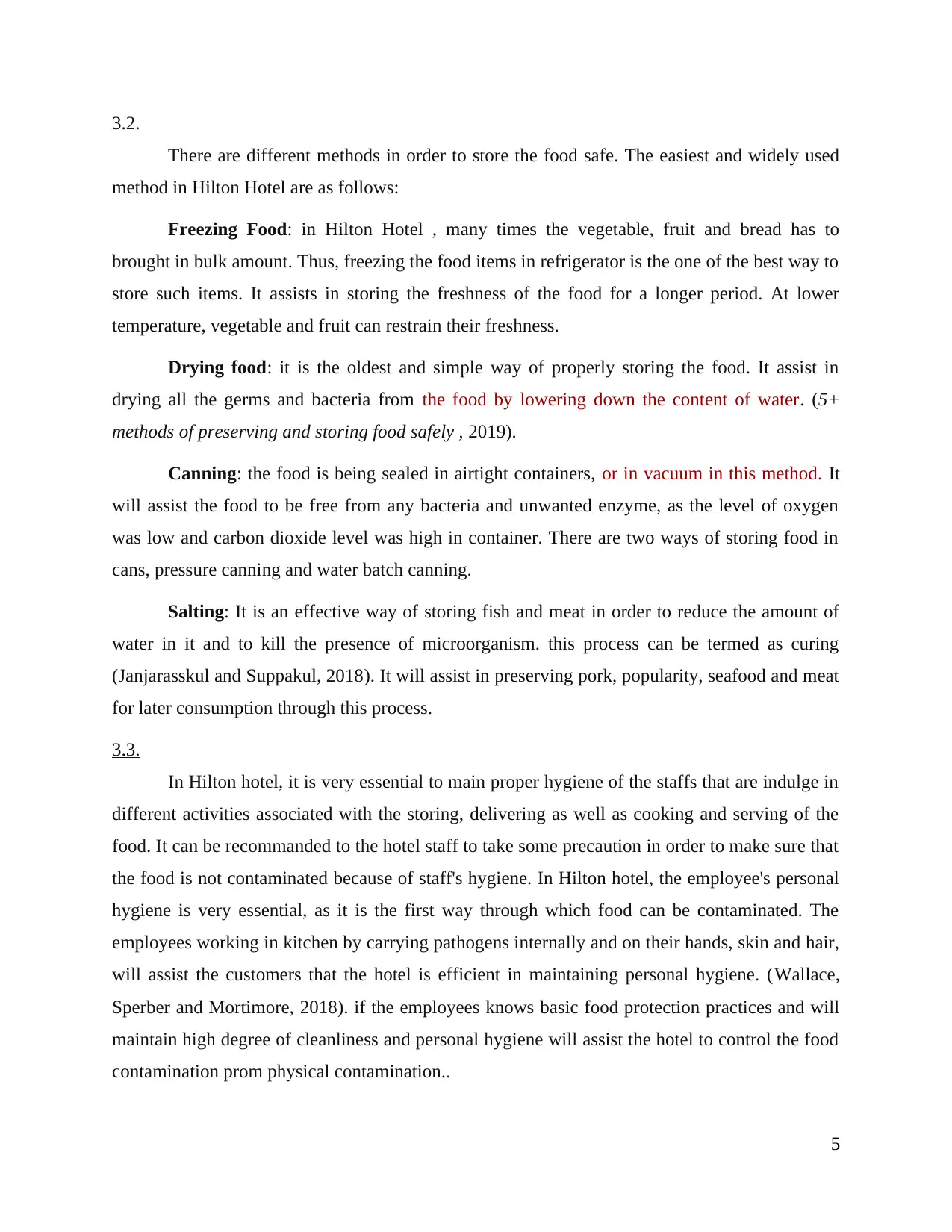
3.2.
There are different methods in order to store the food safe. The easiest and widely used
method in Hilton Hotel are as follows:
Freezing Food: in Hilton Hotel , many times the vegetable, fruit and bread has to
brought in bulk amount. Thus, freezing the food items in refrigerator is the one of the best way to
store such items. It assists in storing the freshness of the food for a longer period. At lower
temperature, vegetable and fruit can restrain their freshness.
Drying food: it is the oldest and simple way of properly storing the food. It assist in
drying all the germs and bacteria from the food by lowering down the content of water. (5+
methods of preserving and storing food safely , 2019).
Canning: the food is being sealed in airtight containers, or in vacuum in this method. It
will assist the food to be free from any bacteria and unwanted enzyme, as the level of oxygen
was low and carbon dioxide level was high in container. There are two ways of storing food in
cans, pressure canning and water batch canning.
Salting: It is an effective way of storing fish and meat in order to reduce the amount of
water in it and to kill the presence of microorganism. this process can be termed as curing
(Janjarasskul and Suppakul, 2018). It will assist in preserving pork, popularity, seafood and meat
for later consumption through this process.
3.3.
In Hilton hotel, it is very essential to main proper hygiene of the staffs that are indulge in
different activities associated with the storing, delivering as well as cooking and serving of the
food. It can be recommanded to the hotel staff to take some precaution in order to make sure that
the food is not contaminated because of staff's hygiene. In Hilton hotel, the employee's personal
hygiene is very essential, as it is the first way through which food can be contaminated. The
employees working in kitchen by carrying pathogens internally and on their hands, skin and hair,
will assist the customers that the hotel is efficient in maintaining personal hygiene. (Wallace,
Sperber and Mortimore, 2018). if the employees knows basic food protection practices and will
maintain high degree of cleanliness and personal hygiene will assist the hotel to control the food
contamination prom physical contamination..
5
There are different methods in order to store the food safe. The easiest and widely used
method in Hilton Hotel are as follows:
Freezing Food: in Hilton Hotel , many times the vegetable, fruit and bread has to
brought in bulk amount. Thus, freezing the food items in refrigerator is the one of the best way to
store such items. It assists in storing the freshness of the food for a longer period. At lower
temperature, vegetable and fruit can restrain their freshness.
Drying food: it is the oldest and simple way of properly storing the food. It assist in
drying all the germs and bacteria from the food by lowering down the content of water. (5+
methods of preserving and storing food safely , 2019).
Canning: the food is being sealed in airtight containers, or in vacuum in this method. It
will assist the food to be free from any bacteria and unwanted enzyme, as the level of oxygen
was low and carbon dioxide level was high in container. There are two ways of storing food in
cans, pressure canning and water batch canning.
Salting: It is an effective way of storing fish and meat in order to reduce the amount of
water in it and to kill the presence of microorganism. this process can be termed as curing
(Janjarasskul and Suppakul, 2018). It will assist in preserving pork, popularity, seafood and meat
for later consumption through this process.
3.3.
In Hilton hotel, it is very essential to main proper hygiene of the staffs that are indulge in
different activities associated with the storing, delivering as well as cooking and serving of the
food. It can be recommanded to the hotel staff to take some precaution in order to make sure that
the food is not contaminated because of staff's hygiene. In Hilton hotel, the employee's personal
hygiene is very essential, as it is the first way through which food can be contaminated. The
employees working in kitchen by carrying pathogens internally and on their hands, skin and hair,
will assist the customers that the hotel is efficient in maintaining personal hygiene. (Wallace,
Sperber and Mortimore, 2018). if the employees knows basic food protection practices and will
maintain high degree of cleanliness and personal hygiene will assist the hotel to control the food
contamination prom physical contamination..
5
Paraphrase This Document
Need a fresh take? Get an instant paraphrase of this document with our AI Paraphraser
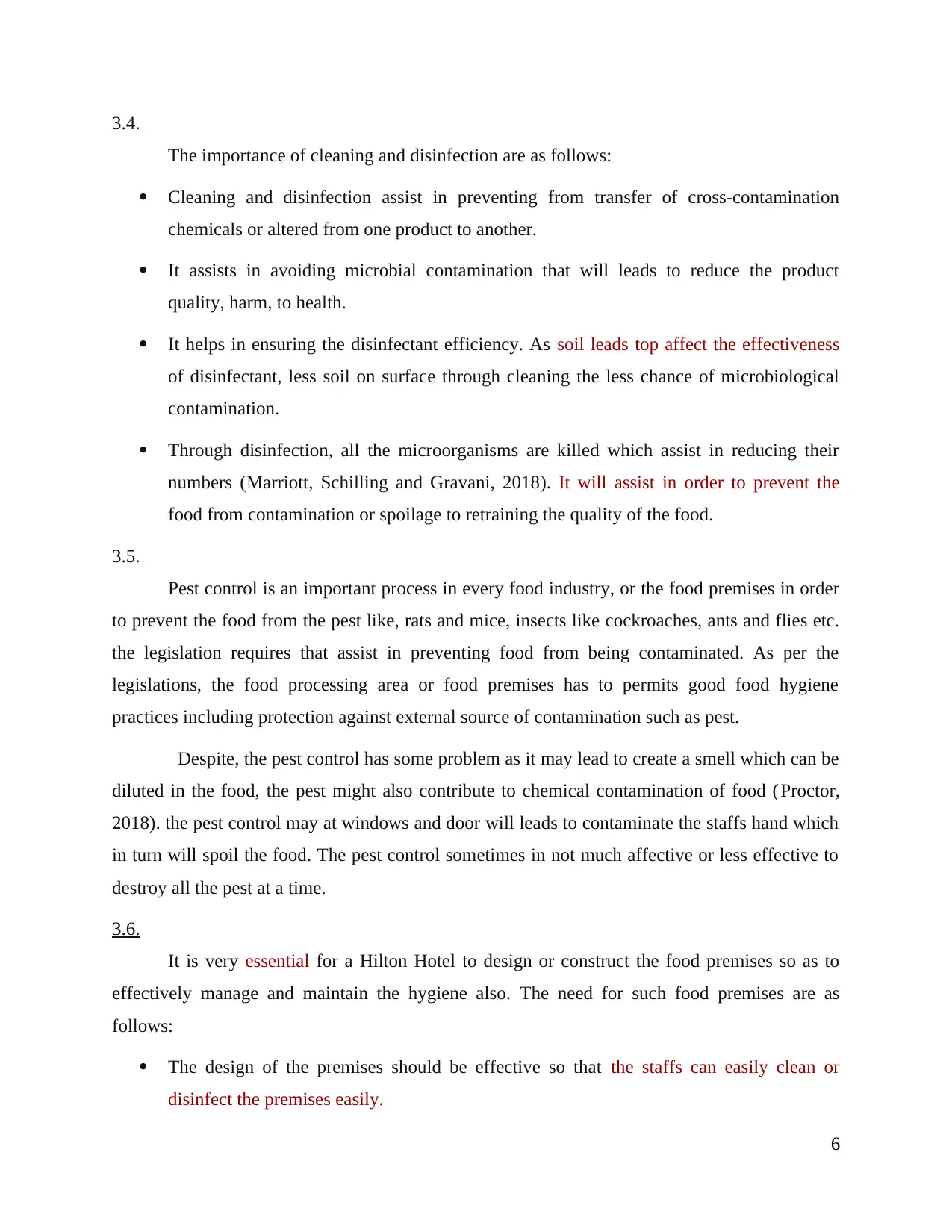
3.4.
The importance of cleaning and disinfection are as follows:
Cleaning and disinfection assist in preventing from transfer of cross-contamination
chemicals or altered from one product to another.
It assists in avoiding microbial contamination that will leads to reduce the product
quality, harm, to health.
It helps in ensuring the disinfectant efficiency. As soil leads top affect the effectiveness
of disinfectant, less soil on surface through cleaning the less chance of microbiological
contamination.
Through disinfection, all the microorganisms are killed which assist in reducing their
numbers (Marriott, Schilling and Gravani, 2018). It will assist in order to prevent the
food from contamination or spoilage to retraining the quality of the food.
3.5.
Pest control is an important process in every food industry, or the food premises in order
to prevent the food from the pest like, rats and mice, insects like cockroaches, ants and flies etc.
the legislation requires that assist in preventing food from being contaminated. As per the
legislations, the food processing area or food premises has to permits good food hygiene
practices including protection against external source of contamination such as pest.
Despite, the pest control has some problem as it may lead to create a smell which can be
diluted in the food, the pest might also contribute to chemical contamination of food (Proctor,
2018). the pest control may at windows and door will leads to contaminate the staffs hand which
in turn will spoil the food. The pest control sometimes in not much affective or less effective to
destroy all the pest at a time.
3.6.
It is very essential for a Hilton Hotel to design or construct the food premises so as to
effectively manage and maintain the hygiene also. The need for such food premises are as
follows:
The design of the premises should be effective so that the staffs can easily clean or
disinfect the premises easily.
6
The importance of cleaning and disinfection are as follows:
Cleaning and disinfection assist in preventing from transfer of cross-contamination
chemicals or altered from one product to another.
It assists in avoiding microbial contamination that will leads to reduce the product
quality, harm, to health.
It helps in ensuring the disinfectant efficiency. As soil leads top affect the effectiveness
of disinfectant, less soil on surface through cleaning the less chance of microbiological
contamination.
Through disinfection, all the microorganisms are killed which assist in reducing their
numbers (Marriott, Schilling and Gravani, 2018). It will assist in order to prevent the
food from contamination or spoilage to retraining the quality of the food.
3.5.
Pest control is an important process in every food industry, or the food premises in order
to prevent the food from the pest like, rats and mice, insects like cockroaches, ants and flies etc.
the legislation requires that assist in preventing food from being contaminated. As per the
legislations, the food processing area or food premises has to permits good food hygiene
practices including protection against external source of contamination such as pest.
Despite, the pest control has some problem as it may lead to create a smell which can be
diluted in the food, the pest might also contribute to chemical contamination of food (Proctor,
2018). the pest control may at windows and door will leads to contaminate the staffs hand which
in turn will spoil the food. The pest control sometimes in not much affective or less effective to
destroy all the pest at a time.
3.6.
It is very essential for a Hilton Hotel to design or construct the food premises so as to
effectively manage and maintain the hygiene also. The need for such food premises are as
follows:
The design of the premises should be effective so that the staffs can easily clean or
disinfect the premises easily.
6
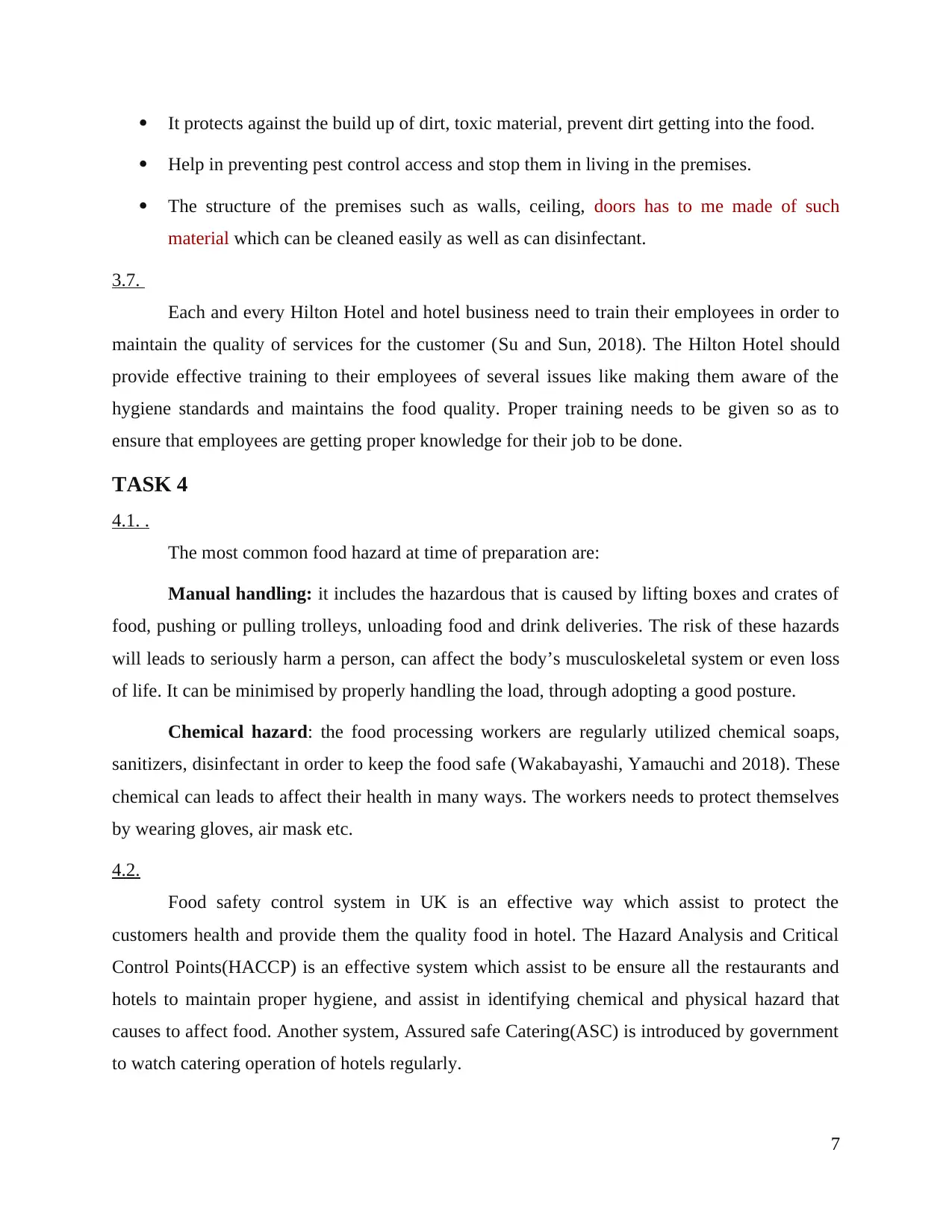
It protects against the build up of dirt, toxic material, prevent dirt getting into the food.
Help in preventing pest control access and stop them in living in the premises.
The structure of the premises such as walls, ceiling, doors has to me made of such
material which can be cleaned easily as well as can disinfectant.
3.7.
Each and every Hilton Hotel and hotel business need to train their employees in order to
maintain the quality of services for the customer (Su and Sun, 2018). The Hilton Hotel should
provide effective training to their employees of several issues like making them aware of the
hygiene standards and maintains the food quality. Proper training needs to be given so as to
ensure that employees are getting proper knowledge for their job to be done.
TASK 4
4.1. .
The most common food hazard at time of preparation are:
Manual handling: it includes the hazardous that is caused by lifting boxes and crates of
food, pushing or pulling trolleys, unloading food and drink deliveries. The risk of these hazards
will leads to seriously harm a person, can affect the body’s musculoskeletal system or even loss
of life. It can be minimised by properly handling the load, through adopting a good posture.
Chemical hazard: the food processing workers are regularly utilized chemical soaps,
sanitizers, disinfectant in order to keep the food safe (Wakabayashi, Yamauchi and 2018). These
chemical can leads to affect their health in many ways. The workers needs to protect themselves
by wearing gloves, air mask etc.
4.2.
Food safety control system in UK is an effective way which assist to protect the
customers health and provide them the quality food in hotel. The Hazard Analysis and Critical
Control Points(HACCP) is an effective system which assist to be ensure all the restaurants and
hotels to maintain proper hygiene, and assist in identifying chemical and physical hazard that
causes to affect food. Another system, Assured safe Catering(ASC) is introduced by government
to watch catering operation of hotels regularly.
7
Help in preventing pest control access and stop them in living in the premises.
The structure of the premises such as walls, ceiling, doors has to me made of such
material which can be cleaned easily as well as can disinfectant.
3.7.
Each and every Hilton Hotel and hotel business need to train their employees in order to
maintain the quality of services for the customer (Su and Sun, 2018). The Hilton Hotel should
provide effective training to their employees of several issues like making them aware of the
hygiene standards and maintains the food quality. Proper training needs to be given so as to
ensure that employees are getting proper knowledge for their job to be done.
TASK 4
4.1. .
The most common food hazard at time of preparation are:
Manual handling: it includes the hazardous that is caused by lifting boxes and crates of
food, pushing or pulling trolleys, unloading food and drink deliveries. The risk of these hazards
will leads to seriously harm a person, can affect the body’s musculoskeletal system or even loss
of life. It can be minimised by properly handling the load, through adopting a good posture.
Chemical hazard: the food processing workers are regularly utilized chemical soaps,
sanitizers, disinfectant in order to keep the food safe (Wakabayashi, Yamauchi and 2018). These
chemical can leads to affect their health in many ways. The workers needs to protect themselves
by wearing gloves, air mask etc.
4.2.
Food safety control system in UK is an effective way which assist to protect the
customers health and provide them the quality food in hotel. The Hazard Analysis and Critical
Control Points(HACCP) is an effective system which assist to be ensure all the restaurants and
hotels to maintain proper hygiene, and assist in identifying chemical and physical hazard that
causes to affect food. Another system, Assured safe Catering(ASC) is introduced by government
to watch catering operation of hotels regularly.
7
⊘ This is a preview!⊘
Do you want full access?
Subscribe today to unlock all pages.

Trusted by 1+ million students worldwide
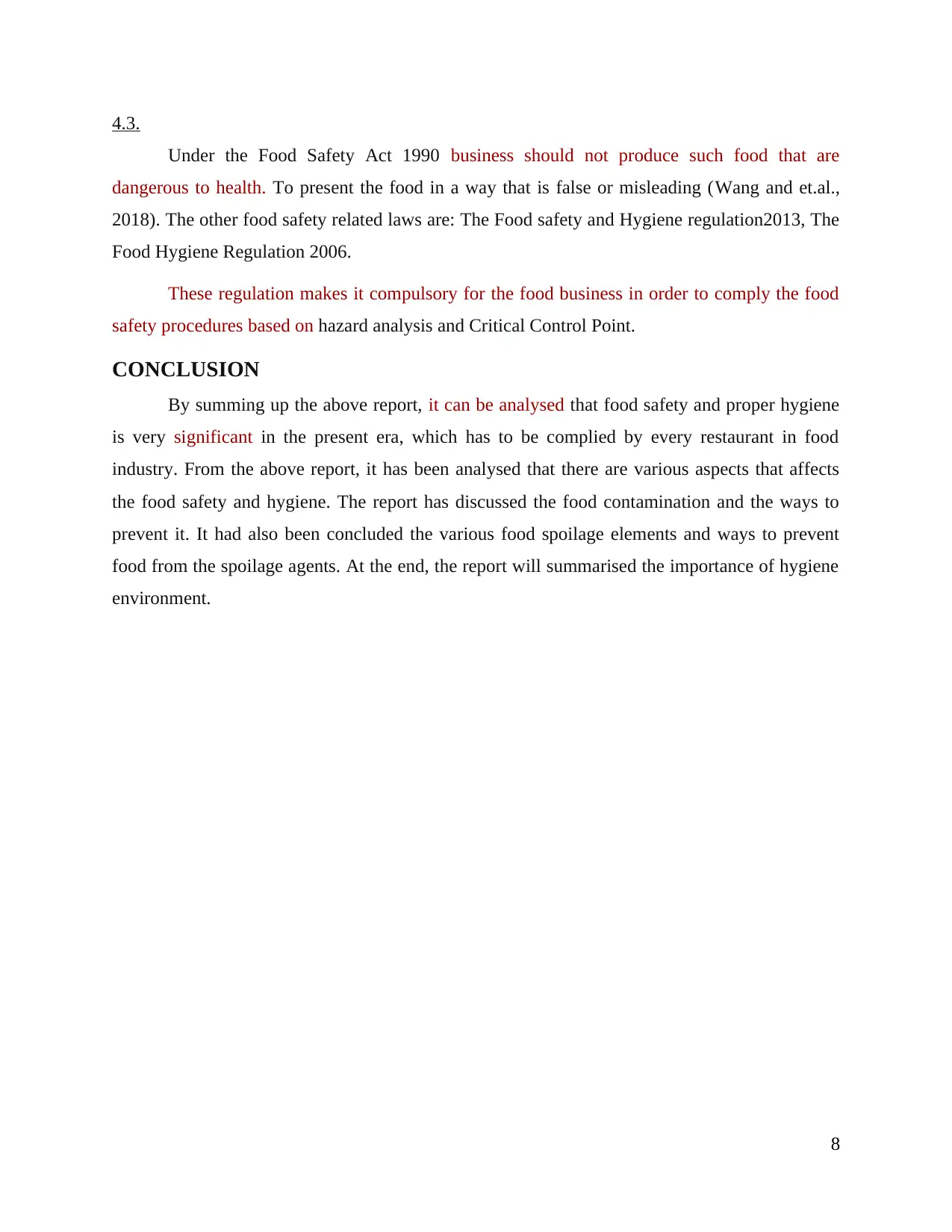
4.3.
Under the Food Safety Act 1990 business should not produce such food that are
dangerous to health. To present the food in a way that is false or misleading (Wang and et.al.,
2018). The other food safety related laws are: The Food safety and Hygiene regulation2013, The
Food Hygiene Regulation 2006.
These regulation makes it compulsory for the food business in order to comply the food
safety procedures based on hazard analysis and Critical Control Point.
CONCLUSION
By summing up the above report, it can be analysed that food safety and proper hygiene
is very significant in the present era, which has to be complied by every restaurant in food
industry. From the above report, it has been analysed that there are various aspects that affects
the food safety and hygiene. The report has discussed the food contamination and the ways to
prevent it. It had also been concluded the various food spoilage elements and ways to prevent
food from the spoilage agents. At the end, the report will summarised the importance of hygiene
environment.
8
Under the Food Safety Act 1990 business should not produce such food that are
dangerous to health. To present the food in a way that is false or misleading (Wang and et.al.,
2018). The other food safety related laws are: The Food safety and Hygiene regulation2013, The
Food Hygiene Regulation 2006.
These regulation makes it compulsory for the food business in order to comply the food
safety procedures based on hazard analysis and Critical Control Point.
CONCLUSION
By summing up the above report, it can be analysed that food safety and proper hygiene
is very significant in the present era, which has to be complied by every restaurant in food
industry. From the above report, it has been analysed that there are various aspects that affects
the food safety and hygiene. The report has discussed the food contamination and the ways to
prevent it. It had also been concluded the various food spoilage elements and ways to prevent
food from the spoilage agents. At the end, the report will summarised the importance of hygiene
environment.
8
Paraphrase This Document
Need a fresh take? Get an instant paraphrase of this document with our AI Paraphraser
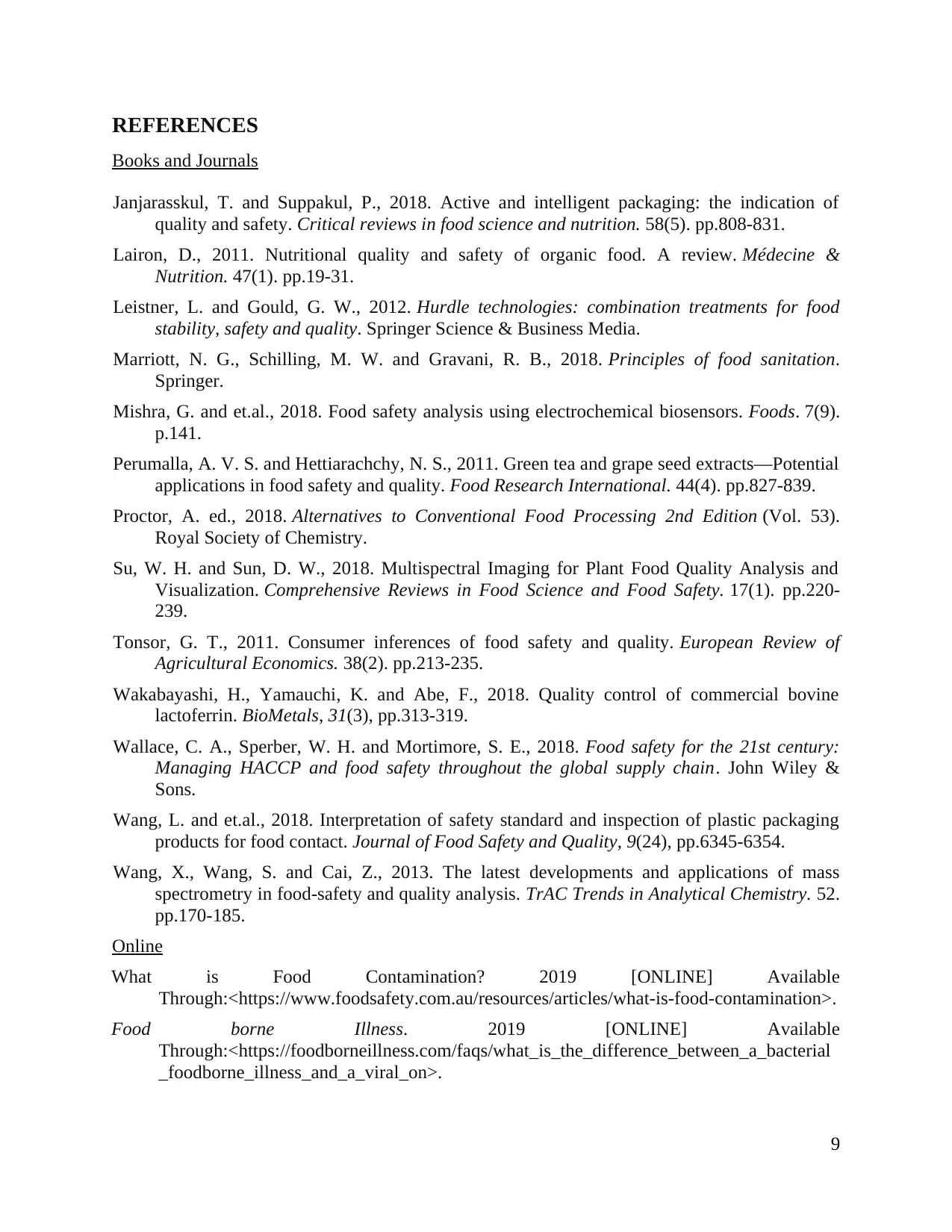
REFERENCES
Books and Journals
Janjarasskul, T. and Suppakul, P., 2018. Active and intelligent packaging: the indication of
quality and safety. Critical reviews in food science and nutrition. 58(5). pp.808-831.
Lairon, D., 2011. Nutritional quality and safety of organic food. A review. Médecine &
Nutrition. 47(1). pp.19-31.
Leistner, L. and Gould, G. W., 2012. Hurdle technologies: combination treatments for food
stability, safety and quality. Springer Science & Business Media.
Marriott, N. G., Schilling, M. W. and Gravani, R. B., 2018. Principles of food sanitation.
Springer.
Mishra, G. and et.al., 2018. Food safety analysis using electrochemical biosensors. Foods. 7(9).
p.141.
Perumalla, A. V. S. and Hettiarachchy, N. S., 2011. Green tea and grape seed extracts—Potential
applications in food safety and quality. Food Research International. 44(4). pp.827-839.
Proctor, A. ed., 2018. Alternatives to Conventional Food Processing 2nd Edition (Vol. 53).
Royal Society of Chemistry.
Su, W. H. and Sun, D. W., 2018. Multispectral Imaging for Plant Food Quality Analysis and
Visualization. Comprehensive Reviews in Food Science and Food Safety. 17(1). pp.220-
239.
Tonsor, G. T., 2011. Consumer inferences of food safety and quality. European Review of
Agricultural Economics. 38(2). pp.213-235.
Wakabayashi, H., Yamauchi, K. and Abe, F., 2018. Quality control of commercial bovine
lactoferrin. BioMetals, 31(3), pp.313-319.
Wallace, C. A., Sperber, W. H. and Mortimore, S. E., 2018. Food safety for the 21st century:
Managing HACCP and food safety throughout the global supply chain. John Wiley &
Sons.
Wang, L. and et.al., 2018. Interpretation of safety standard and inspection of plastic packaging
products for food contact. Journal of Food Safety and Quality, 9(24), pp.6345-6354.
Wang, X., Wang, S. and Cai, Z., 2013. The latest developments and applications of mass
spectrometry in food-safety and quality analysis. TrAC Trends in Analytical Chemistry. 52.
pp.170-185.
Online
What is Food Contamination? 2019 [ONLINE] Available
Through:<https://www.foodsafety.com.au/resources/articles/what-is-food-contamination>.
Food borne Illness. 2019 [ONLINE] Available
Through:<https://foodborneillness.com/faqs/what_is_the_difference_between_a_bacterial
_foodborne_illness_and_a_viral_on>.
9
Books and Journals
Janjarasskul, T. and Suppakul, P., 2018. Active and intelligent packaging: the indication of
quality and safety. Critical reviews in food science and nutrition. 58(5). pp.808-831.
Lairon, D., 2011. Nutritional quality and safety of organic food. A review. Médecine &
Nutrition. 47(1). pp.19-31.
Leistner, L. and Gould, G. W., 2012. Hurdle technologies: combination treatments for food
stability, safety and quality. Springer Science & Business Media.
Marriott, N. G., Schilling, M. W. and Gravani, R. B., 2018. Principles of food sanitation.
Springer.
Mishra, G. and et.al., 2018. Food safety analysis using electrochemical biosensors. Foods. 7(9).
p.141.
Perumalla, A. V. S. and Hettiarachchy, N. S., 2011. Green tea and grape seed extracts—Potential
applications in food safety and quality. Food Research International. 44(4). pp.827-839.
Proctor, A. ed., 2018. Alternatives to Conventional Food Processing 2nd Edition (Vol. 53).
Royal Society of Chemistry.
Su, W. H. and Sun, D. W., 2018. Multispectral Imaging for Plant Food Quality Analysis and
Visualization. Comprehensive Reviews in Food Science and Food Safety. 17(1). pp.220-
239.
Tonsor, G. T., 2011. Consumer inferences of food safety and quality. European Review of
Agricultural Economics. 38(2). pp.213-235.
Wakabayashi, H., Yamauchi, K. and Abe, F., 2018. Quality control of commercial bovine
lactoferrin. BioMetals, 31(3), pp.313-319.
Wallace, C. A., Sperber, W. H. and Mortimore, S. E., 2018. Food safety for the 21st century:
Managing HACCP and food safety throughout the global supply chain. John Wiley &
Sons.
Wang, L. and et.al., 2018. Interpretation of safety standard and inspection of plastic packaging
products for food contact. Journal of Food Safety and Quality, 9(24), pp.6345-6354.
Wang, X., Wang, S. and Cai, Z., 2013. The latest developments and applications of mass
spectrometry in food-safety and quality analysis. TrAC Trends in Analytical Chemistry. 52.
pp.170-185.
Online
What is Food Contamination? 2019 [ONLINE] Available
Through:<https://www.foodsafety.com.au/resources/articles/what-is-food-contamination>.
Food borne Illness. 2019 [ONLINE] Available
Through:<https://foodborneillness.com/faqs/what_is_the_difference_between_a_bacterial
_foodborne_illness_and_a_viral_on>.
9
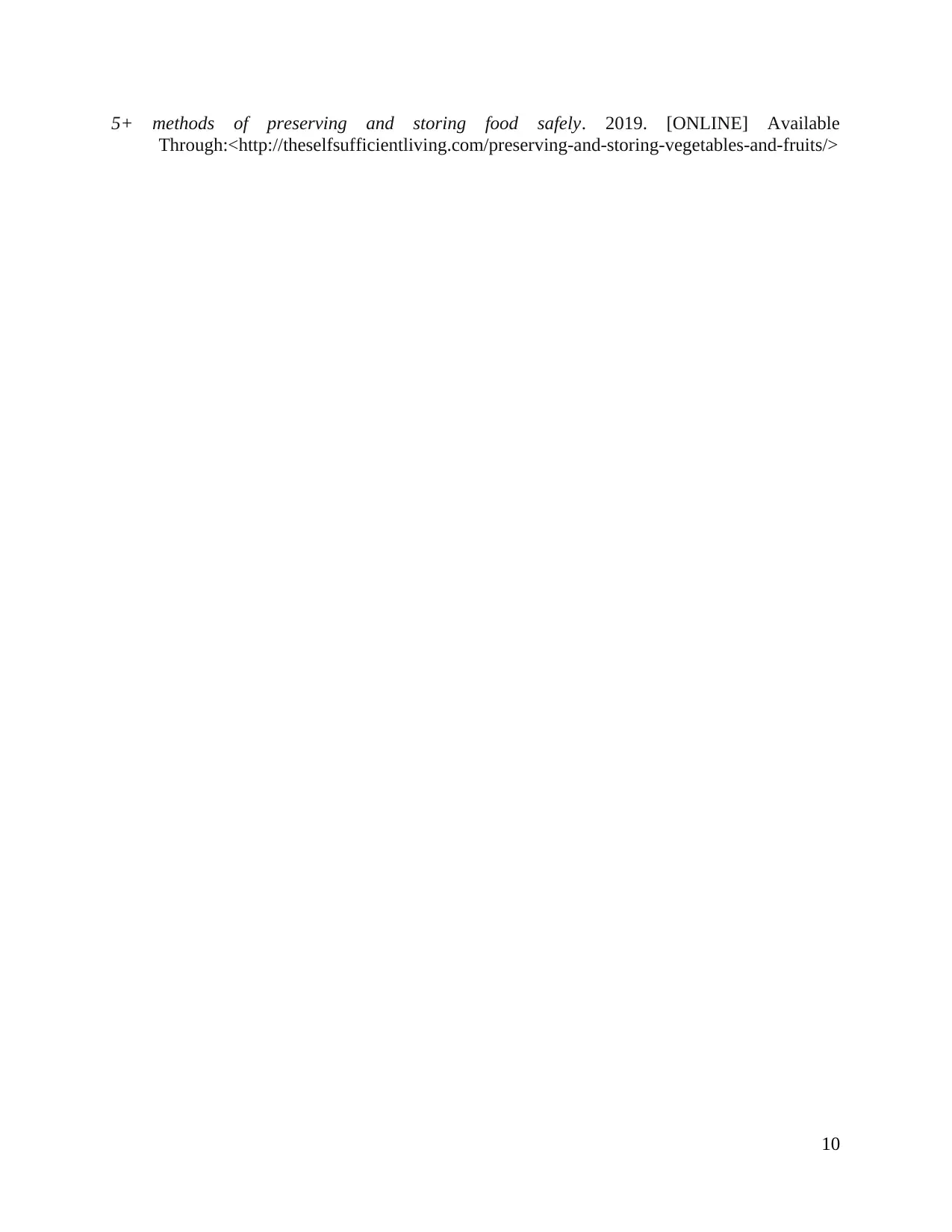
5+ methods of preserving and storing food safely. 2019. [ONLINE] Available
Through:<http://theselfsufficientliving.com/preserving-and-storing-vegetables-and-fruits/>
10
Through:<http://theselfsufficientliving.com/preserving-and-storing-vegetables-and-fruits/>
10
⊘ This is a preview!⊘
Do you want full access?
Subscribe today to unlock all pages.

Trusted by 1+ million students worldwide
1 out of 12
Related Documents
Your All-in-One AI-Powered Toolkit for Academic Success.
+13062052269
info@desklib.com
Available 24*7 on WhatsApp / Email
![[object Object]](/_next/static/media/star-bottom.7253800d.svg)
Unlock your academic potential
Copyright © 2020–2025 A2Z Services. All Rights Reserved. Developed and managed by ZUCOL.





